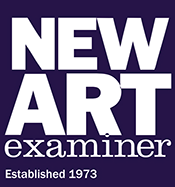
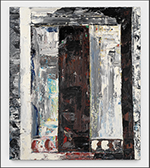

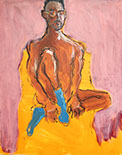

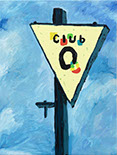
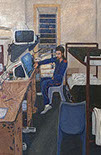
Myths of Ruin and Resurgence:
Scott Hocking at Cranbrook Art Museum
by K.A. Letts
…Two vast and trunkless legs of stone
Stand in the desert…Near them, on the sand,
Half sunk a shattered visage lies…
From Ozymandias by Percy Bysshe Shelley
Urban archeologist, historian of the transient and visionary lover of an once-and-future great metropolis, installation artist Scott Hocking tells the story of Detroit’s decay and rebirth in his mid-career museum retrospective. The elaborate constructs and documentary photographs in the exhibition go far beyond the voyeuristic photographs of urban devastation—often called ruin porn—that were fashionable in the early 2000s and to which they are occasionally compared. His thoughtful and empathetic examinations of the city’s abandoned spaces, augmented by built interventions and documented in all their precarity, have provided a conceptual template for projects beyond the city, in the artist’s native upstate Michigan, in Florida and New York and even further afield in France, Germany, Australia, Iceland and China.
Hocking’s work is difficult to represent in a museum setting, since his iconic installations are site specific, often monumental in scale and ephemeral—either by happenstance or by design. However, Cranbrook Curator Andrew Satake Blauvelt has managed to assemble an assortment of documentary photos of Hocking’s most memorable works, along with reconstituted installations and large-scale sculptures that accurately represent what the artist has been up to for the last 25 years. Hocking, a gifted writer, has also contributed a series of wall titles for the exhibition that provide eloquent commentary throughout. An accompanying 344-page catalog, with ample supporting text by Blauvelt, an interview with the artist by Laura Mott, Chief Curator of Cranbrook Art Museum, and a scholarly essay by Michael Stone Richards, rounds out a complete consideration of the artist’s accomplishments and projects to date. “Scott Hocking: Detroit Stories” will be on view at Cranbrook Art Museum until March 19, 2023.
A self-described working-class kid from Redford Township on the outskirts of Detroit, Hocking grew up in a modest home on a dirt road, near a railroad track. He became, early on, an intrepid seeker of grand, derelict spaces and structures in Detroit. As he explored the city on foot, he was one of the few to see something brave and worthy of salvaging in what most had dismissed as a failed city.
Hocking’s creative impulses have often begun with irritation—from his annoyance with the cute and kitschy public art animals painted decoratively in various cities in the early 2000s to his anger at the sheer waste of the once-opulent and now neglected buildings to which he is drawn. He scouts locations; in the past they have been grand and desolate urban structures where an atmosphere of privilege lingers. Responding to the residual beauty in these former showplaces, Hocking casts about the immediate environment for materials. Then, slowly and painstakingly, he reconstitutes them in new form in a process he describes as a meditation on post-industrial obsolescence.
One of Hocking’s early installations, Ziggurat and Fisher Body Plant 21 (2007-2009), both encapsulates and foreshadows the direction of his art practice in the years since. Ziggurat was a site-specific sculptural installation made from 6,201 square chunks of end grain wood the artist found within Detroit’s abandoned Fisher Body Plant 21. Vacant since the early 1990s, the enormous, 650,000 square foot FB21 had become a man-made cave, complete with stalagmites. Trees grew on the roof. “The Packard [plant] was (and is) seen as the big fat shining symbol of Detroit’s failures, the once-mighty auto capital turned into the shrinking city of the future,” he says in an interview. Scrappers had long ago stripped the factory, but the floor blocks remained. Inspired by the factory’s concrete-columned industrial architecture, Hocking began to imagine the interior, characterized by tranquil natural light and soaring space, as a sacred environment to house a kind of stepped temple. Beginning in August 2008, and for 18 months thereafter, Hocking gathered the scattered blocks and stacked them painstakingly into a pyramid. “I wanted to question the idea of a ruin versus a monument, building a ruin within a ruin and juxtaposing postindustrial ruination with the ancient past,” he explained. The structure lasted only a few months. He describes the fate of his ad hoc monument:
“It was destroyed when the EPA took over and cleaned out the hazardous creosote-preserved floor blocks. Five months later, the EPA was gone and FB21 was again reclaimed by scrappers. Since then, the site has been repeatedly boarded up and torn open, with occasional press declaring a potential renovation, a loft complex or a music venue, including the latest proposal to transform the beast into an apartment and retail complex by 2025.”
Ziggurat and FB21, like many of Hocking’s constructs, exists now only as a memory and a documentary photograph. The artist views the final state of his works to be large-format color photographs of the elaborate structures he has laboriously created. He has accepted both the intense labor required to alter his chosen settings and their ultimate impermanence as they become part of the perpetual struggle between human effort and natural forces.
One of Detroit’s most famous architectural ruins, Michigan Central Station, provides the site for another of Hocking’s best known built visions. In The Egg and MCTS (2007-2013), monumentality and ephemerality are conceptually balanced in a surreal, delicate and precariously balanced ovoid form. Temporary yet timeless, the installation and photography project was created on the eighth floor of an architectural ruin that had been vacant for over 20 years. In that time the interior of the building had slowly shed sheets of broken marble from its walls, providing the raw material for Hocking’s stacked egg. The artist described the archetypal form’s intended meaning as “the unborn potential, yet to be hatched, the new beginning, rebirth, the gestating of primordial matter, creation and the etheric aura that surrounds each human.”
The Egg was destroyed in 2014.
Fortunately, not all of Hocking’s artworks have been reduced to their photographic—if handsome—documentation. Several large and satisfyingly physical installations have been re-constituted in the museum for this retrospective, the viscerally physical wall installation RELICS among them. Working with fellow Detroit artist Clinton Snyder, Hocking has, over time, collected thousands of bits and pieces of the city’s substance into 200 carefully curated and displayed boxes that fill an entire wall of the gallery. Here are tiles, skulls, embroidered name tags, rope, plastic toys, statuettes of galleons and scantily clad ladies, abandoned signs, keys, tools, bottles, pipes and more in neat rows. The intent is to overload the viewer with the sheer abundance of artifacts that make up Detroit’s natural history. Hocking explains, “These are our contemporary relics, and within them is our history…. In 300-some years, Detroit has gone from marshes, forests and wildlife, to farmland and expansive industry, to post-industrial wasteland and waning population, and now, once again, it is rebirthing like a phoenix from the ashes.”
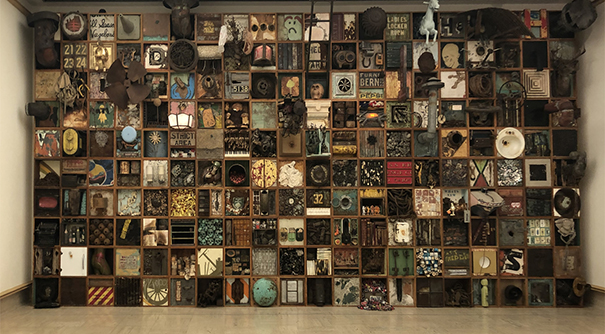
Scott Hocking and Clinton Snyder, RELICS, 2001-present. Mixed media assemblage, size variable. Photo: K.A. Letts.
Though Hocking’s strategy for producing art was formed in Detroit, he has since exported his method to locations outside the city. His Celestial Ship of the North (Emergency Ark) AKA The Barnboat (2016), a site-specific installation and permanent sculpture, was commissioned in 2015 by Jim Boyle as the second in a series, 53 North Detroit to Port Austin. Barnboat was constructed over four months from the scraps of a collapsed 1890s barn located on the Bill and Lorraine Goretski farm in Michigan’s “thumb.” The ghostly yet lyrical form recalls ancient vessels and mythic stories of the Biblical deluge; built into the concept of the structure is the expectation of its eventual decay and destruction from natural forces of wind and weather.
In 2020, Hocking was commissioned to create a sculptural work for “State of the Art 2020” at the Crystal Bridges museum in Bentonville, Arkansas. A 100-year-old, 40-foot tall, tri-legged Aermotor 602 windmill that the artist discovered lying derelict in rural Michigan provided inspiration for what became a meditation on the transience and environmental waste inherent in the industrial history of the nation. Arkansas Traveler—named for a song, a legend, a tomato plant—lounges drunkenly on the gallery floor and brings to mind a haloed Madonna or Don Quixote’s misapprehended windmills. The structure has been painted “bone black,” an ongoing element in the artist’s work based on its historical association with Detroit manufacturing. (The charred skeletons of animals, and most particularly, bison bones, were shipped by rail from the West to the city in the 1890s, where immense piles of them were processed to make fertilizer and additives for refining sugar, as well as for their use as a pigment. Bone black is still produced in Wayne County, Michigan.)
Hocking’s keen interest and proprietary sense of ownership in Detroit’s regional history finds poignant expression in Kayaking Through the Quarantimes 2020-2021, a single channel video that compiles the artist’s numerous kayak trips into a narrative that, over time, observes the industrial waterfront as it transitions back into its primordial natural state. The water-level vantage point and the quiet of the river brings us back to a time before noisy civilization arrived. As the video closes, Hocking smiles his satisfaction with this return to nature. “As technology spreads into the future,” he says, “the obsolete are left behind. New things are created while past creations decay. Nature begins to take apart what we once struggled to assemble. There is a threshold that’s hard to pinpoint, when the man-made object becomes nature again…For most of my life Detroit has epitomized this transition.”
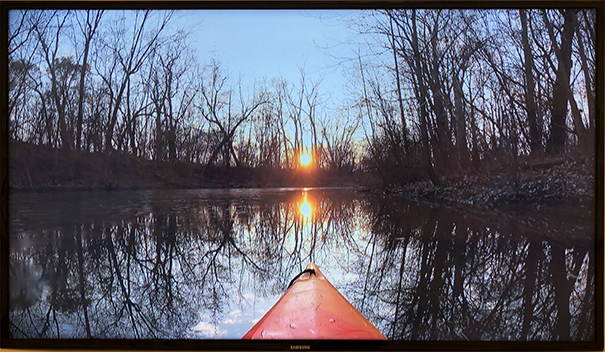
Scott Hocking, Kayaking Through the Quarantimes, 2020-2022. Video still. Photo: K.A. Letts.
Hocking’s recently completed sculpture, Nike of the Straits (2021), adds a poetic coda to his communion with the waterfront. A winged tower looking out over the Detroit River and made from repurposed metal buoys, the visual reference to the Greek goddess of victory is immediately apparent. But this Nike has suffered greatly—and prevailed.
The identity of Detroit has changed—is changing—from 20th century beleaguered victim of inexorable macro-economic and social forces to scrappy 21st century multi-cultural city, all hustle and hard work. As this new iteration continues its lurching progress toward full viability, Hocking’s focus seems to be moving ever back in time, receding into the past, before the artifacts of the industrial city itself were built. He looks back to the era of the voyageurs three hundred years ago, and before that to the time of the Anishinaabeg people, and even earlier, to the 6000 years when nature ruled the river and the straits. Hocking’s considerable powers of observation—his idiosyncratic combination of archeology, anthropology, on-foot and by-boat research, transformed into physical installation and observed through photography, will serve as the means by which his investigation of his native place continues.
Scott Hocking is represented by David Klein Gallery.
K.A. Letts is the Detroit editor of the New Art Examiner, a working artist (kalettsart.com) and art blogger (rustbeltarts.com). She has shown her paintings and drawings in galleries and museums in Toledo, Detroit, Chicago, and New York. She writes frequently about art in the Detroit area.
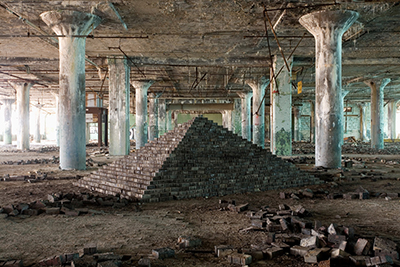
Scott Hocking, Zigguarat and Fisher Body 21, East Summer 1, 2008. Large format photograph 33” x 49.” Photo courtesy David Klein Gallery.

Scott Hocking, Egg and Michigan Central Train Station, 2007-2013, #4718. Large format photograph 33” x 49.” Photo courtesy David Klein Gallery.
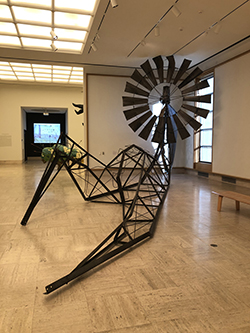
_aka_the_barnboat_8420.jpg?crc=3762864032)
Scott Hocking, Arkansas Traveler, 2022. Installation, Cranbrook Art Museum. Photo: K.A. Letts.
Scott Hocking, Celestial Ship of the North (Emergency Ark) aka Barnboat, 2015. Salvaged barn permanent site-specific sculpture and large format photograph 33” x 49,” (detail). Photo courtesy David Klein Gallery.
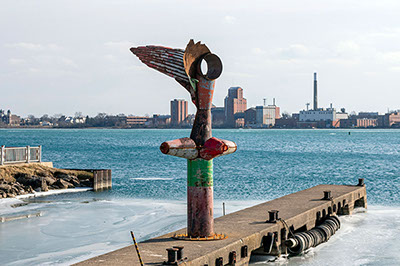
Scott Hocking, Nike of the Strait, 2020–2022. Decommissioned U.S. Coast Guard buoys, channel markers, various steel and hardware, 216” x 120” x 108. Photo: Joan Mitchell Foundation.